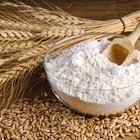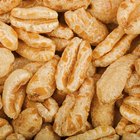More Articles

Bread and flour in their various ways are among the most fundamental and universal of foods, as anyone who's ever gone gluten-free can attest. That's why many diners are disconcerted to learn that as simple a thing as flour often has a long list of ingredients on the side of the package. Although some of those additives have impressively long names, most play relatively simple and innocuous roles.
Flour Milling
Grains of wheat have a straightforward structure. They're primarily seeds, meant to grow new wheat plants, and the embryonic wheat plant -- called the germ -- is at the bottom of the grain. The new plant's starchy food supply, called the endosperm, makes up most of the kernel. Finally, the thin layer of reddish-brown bran surrounds and protects everything else. When the grains are milled for flour, the bran and germ are separated from the endosperm. The ground endosperm becomes white flour, while whole wheat flour has some germ and bran added back in.
Nutrients
Modern milling takes place on a series of high-speed steel rollers. As the grain passes across these rollers and is milled into ever-finer powder, it's heated dramatically by friction. That heat, like any other cooking process, destroys many of the natural nutrients in the flour. For decades, commercial flour mills in the United States have replaced those lost nutrients to produce "enriched" flour. The nutrients include B-vitamins niacin, thiamine and riboflavin, as well as iron and folic acid. Some brands also include calcium.
Bleaching Agents
For centuries millers and bakers have known that freshly-milled flour had relatively weak gluten, and produced dense breads. After exposure to oxygen over time, the flour became paler and its gluten strength improved dramatically. In the late 19th century millers learned that they could simulate this aging process by treating the flour with chlorine gas or potassium bromate as bleaching agents. Both are potentially hazardous, and American mills usually now use ascorbic acid -- also known as Vitamin C -- to oxidize and age the flour. Aside from its effect in improving gluten, bleaching gives the flour a purer white color that's desirable in certain uses such as cakes and white breads.
Dough Conditioners
Some flours, especially in Europe, add extra ingredients to help the flour produce good bread dough. These are often barley or wheat malt, sprouted and dried grains rich in natural enzymes that help break down the flour's carbohydrate molecules and free up its natural sugars. Some also contain fava bean or soybean flour, which also increase the strength and stretchiness of the wheat flour's gluten strands.
Related Articles
Is Unbleached Flour the Same as ...

Can You Use Bread Flour Instead of ...

Alternative Flours to Make Pizza

Can You Substitute Whole Wheat Pastry ...

Differences Between Bleached Flour & ...

Is Teff Flour Gluten-Free?

What Is White Oat?

Does Yeast Cause Holes in Bread?

Does Flour Get Old or Go Bad?

Staple Foods in Africa

What Is Arnel Vintage Material Fabric?

What Is the Nutritional Value of Wheat?

Uses of Cassava Flour

How to Cook With Kamut

Chemicals in Enriched Flour

Can I Substitute Bleached for ...

Psyllium Husk & Gluten
What Gives Pumpernickel Bread Its Dark ...

A List of Leavening Agents

What Is Stone-Ground Wheat?
References
- On Food and Cooking: The Science and Lore of the Kitchen; Harold McGee
Writer Bio
Fred Decker is a trained chef and prolific freelance writer. In previous careers, he sold insurance and mutual funds, and was a longtime retailer. He was educated at Memorial University of Newfoundland and the Northern Alberta Institute of Technology. His articles have appeared on numerous home and garden sites including GoneOutdoors, TheNest and eHow.
Photo Credits
Jupiterimages/Goodshoot/Getty Images